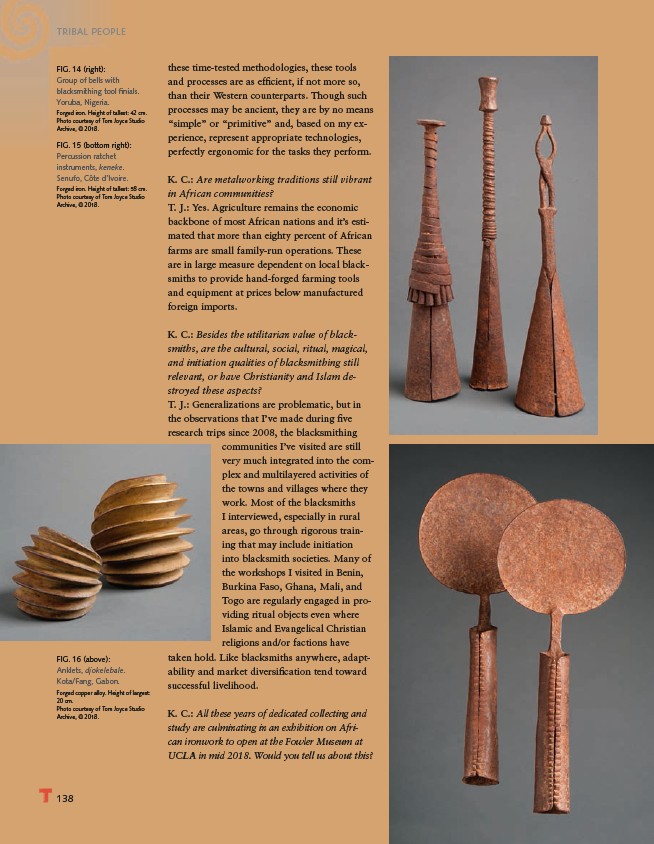
TRIBAL PEOPLE
138
these time-tested methodologies, these tools
and processes are as effi cient, if not more so,
than their Western counterparts. Though such
processes may be ancient, they are by no means
“simple” or “primitive” and, based on my experience,
represent appropriate technologies,
perfectly ergonomic for the tasks they perform.
K. C.: Are metalworking traditions still vibrant
in African communities?
T. J.: Yes. Agriculture remains the economic
backbone of most African nations and it’s estimated
that more than eighty percent of African
farms are small family-run operations. These
are in large measure dependent on local blacksmiths
to provide hand-forged farming tools
and equipment at prices below manufactured
foreign imports.
K. C.: Besides the utilitarian value of blacksmiths,
are the cultural, social, ritual, magical,
and initiation qualities of blacksmithing still
relevant, or have Christianity and Islam destroyed
these aspects?
T. J.: Generalizations are problematic, but in
the observations that I’ve made during fi ve
research trips since 2008, the blacksmithing
communities I’ve visited are still
very much integrated into the complex
and multilayered activities of
the towns and villages where they
work. Most of the blacksmiths
I interviewed, especially in rural
areas, go through rigorous training
that may include initiation
into blacksmith societies. Many of
the workshops I visited in Benin,
Burkina Faso, Ghana, Mali, and
Togo are regularly engaged in providing
ritual objects even where
Islamic and Evangelical Christian
religions and/or factions have
taken hold. Like blacksmiths anywhere, adaptability
and market diversifi cation tend toward
successful livelihood.
K. C.: All these years of dedicated collecting and
study are culminating in an exhibition on African
ironwork to open at the Fowler Museum at
UCLA in mid 2018. Would you tell us about this?
FIG. 14 (right):
Group of bells with
blacksmithing tool fi nials.
Yoruba, Nigeria.
Forged iron. Height of tallest: 42 cm.
Photo courtesy of Tom Joyce Studio
Archive, © 2018.
FIG. 15 (bottom right):
Percussion ratchet
instruments, keneke.
Senufo, Côte d’Ivoire.
Forged iron. Height of tallest: 58 cm.
Photo courtesy of Tom Joyce Studio
Archive, © 2018.
FIG. 16 (above):
Anklets, djokelebale.
Kota/Fang, Gabon.
Forged copper alloy. Height of largest:
20 cm.
Photo courtesy of Tom Joyce Studio
Archive, © 2018.